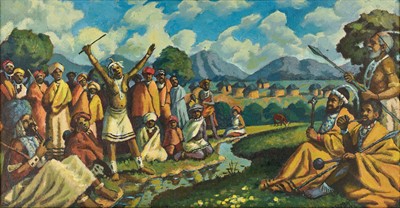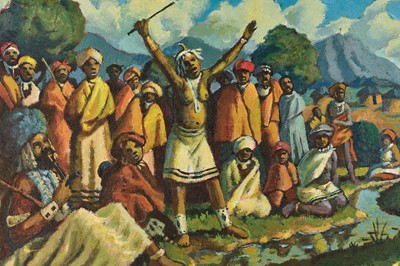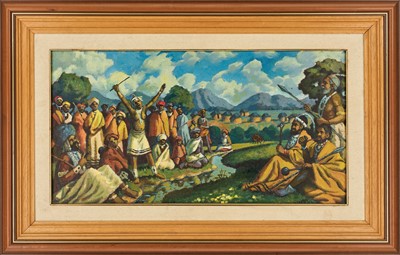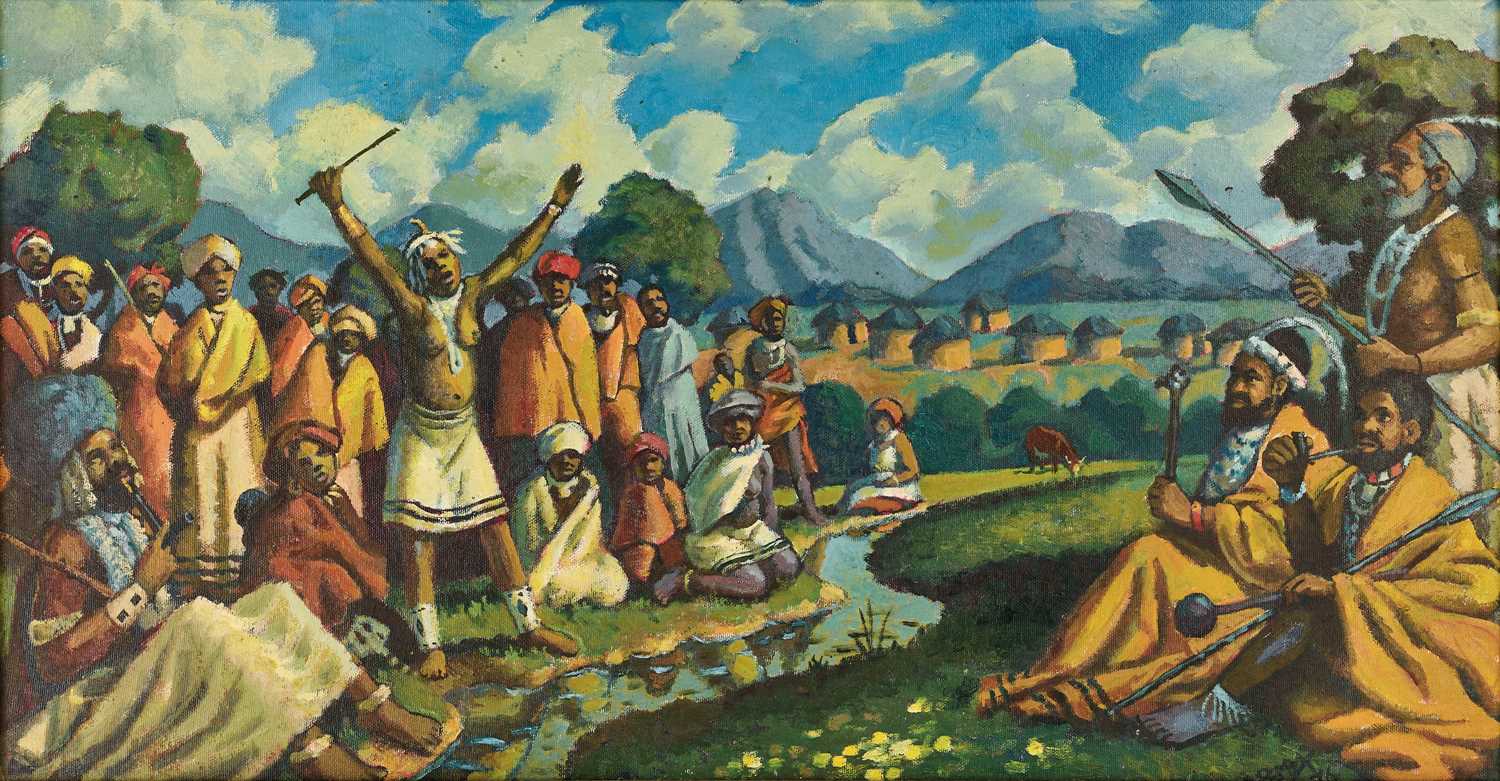16th Mar, 2022 19:00
Modern and Contemporary Art | Cape Town
15
George Pemba (South Africa 1912-2001)
Nongqawuse (The girl who killed to save)
oil on canvas board
Artwork date: 1976
Signature details: signed and dated bottom right; inscribed with the artist's name and title on a Little Gallery label and a Pretoria Art Museum label on the reverse
Exhibited: The Pretoria Art Museum, Pretoria, 1986, catalogue number 75.
Sold for R910,400
Estimated at R400,000 - R600,000
Condition Report
The overall condition is very good. The colours are vibrant and stable.
Minor fly-specks in areas.
Please note, we are not qualified conservators and these reports give our opinion as to the general condition of the works. We advise that bidders view the lots in person to satisfy themselves with the condition of prospective purchases.
oil on canvas board
Artwork date: 1976
Signature details: signed and dated bottom right; inscribed with the artist's name and title on a Little Gallery label and a Pretoria Art Museum label on the reverse
Exhibited: The Pretoria Art Museum, Pretoria, 1986, catalogue number 75.
(1)
39 x 74 cm; framed size: 64 x 99 x 5 cm
Provenance:
Private collection, Johannesburg.
Strauss & Co., South African and International Art, 30 June 2014, Lot 231.
The Little Gallery, Port Elizabeth.
Notes:
Working in relative isolation in the Eastern Cape over a career that spanned some seven decades, George Pemba’s paintings reflect his complex assimilation via books and reproductions of the narrative traditions of the European Old Masters and 19th century Realism, as well as the formal innovations of French Impressionism and Post-Impressionism. From the later 1940s onwards, as he gradually abandoned his academic watercolour painting technique in favour of oil, he applied these different traditions of pictorial representation with greater vigour to a variety of subjects, ranging from portraiture to landscape, as well ‘genre’ scenes of ‘township’ life and reconstructed historical narratives.
Painted some twelve years apart, Pemba’s Nongqawuse (The girl who killed to save) (1976) and The Quarrel (1988) exemplify the last of these aforementioned subject categories. The mood in these paintings traverses the dramatic and even the melodramatic. In them, Pemba makes characteristic use of the vocabulary of 19th century European narrative painting, with its emphasis on gesture and exaggerated expression to generate a response in the viewer.
The Quarrel is one of many of Pemba’s lively genre scenes of community life that reflects something of the traditional moralising intent of much 19th century European painting. The immediacy of the violent physical assault and robbery underway between the three protagonists in Pemba’s rendering, leaves the viewer to ponder varied questions. Who of the role-players might be the real victim and who the perpetrator? What situation might have precipitated this violence? Implicit to the meaning of this work, is the ideal that physical violencein human societal relations ought not to occur.
On the other hand, Nongqawuse (The girl who killed to save), is an imagined reconstruction of an historical event. It is the most successful, expansive and important of all of Pemba’s iterations of this key scene from the suicidal ‘cattlekilling movement’ in the history of his own Xhosa people. A number of smaller versions of this subject were painted by Pemba, notably The Dream (1989) which is in the collection of the South African National Gallery in Cape Town.
The tragedy, precipitated by the supposed visions of a 15 year-old girl named Nongqawuse, led to the death, famine and ultimate colonial subjugation of the Xhosa people between 1856 and 1858. Obviously well-versed in the details of this historical event, Pemba had earlier written a musical play on this very same theme, based on H.I.E. Dhlomo’s drama The Girl Who Killed to Save (1935).
In 1856, Nongqawuse and a friend went to visit her uncle Mhlakaza’s crops in fields near the mouth of the Gxarha River. When she returned, Nongqawuse told her uncle that there she had encountered several ancestral spirits. These spirits, she claimed, had told her that the Xhosa nation should destroy all of their crops and their cattle as a prophetic precondition for a miraculous renewal of Xhosa agricultural prosperity, the resurrection of the dead and the annihilation of the European settlers. Nongqawuse’s uncle, Mhlakaza, did not believe her story at first, but when she accurately described the appearance of one of the spirits as his dead diviner-brother Mhalakaza, he was finally convinced. Mhlakaza conveyed news of the prophecy to the Xhosa King Sarili and his Gcaleka clan. This caused a cattle-killing frenzy that ultimately spread and a"ected the whole of the Xhosa nation. Between 300,000 and 400,000 head of cattle were destroyed with devastating and decimating consequences for the population.
With its panoramic crowd scene set against a broad landscape, Pemba’s painting Nongqawuse (The girl who killed to save) accurately features the key dramatis personae of this epic tragedy. Nongqawuse stands bare-breasted to the left of centre, with her arms outstretched, as if in a trance. The seated male figure in Xhosa diviners’ attire in the bottom left-hand corner is her uncle Mhlakaza. The placid stream which diagonally divides the foreground possibly represents the Gxarha River where she claimed to have experienced her visions. The idyllic landscape setting with its pastures and homesteads, including one of the cattle that was ultimately to be slaughtered, reflects Xhosa prosperity before the cataclysm. On the right hand side of the painting, raptly attentive to Nongqawuse’s prophecy, are seated the great Gcaleka chiefs of the Xhosa
kingdom. Wearing his royal regalia, with a crane feather, ceremonial beadwork and bearing his staff of choice in his hand, is seated King Sahrili. Seated next to him in the bottom right-hand corner is Mhlataza, the guardian of Nongqawuse, who was also the Sahrili’s adviser. [1]
Hayden Proud
[1] I am grateful to Carol Kaufmann for her assistance in identifying the key historical figures in this painting via their traditional apparel and beadwork.
You can place an absentee bid through our website - please sign in to your account on our website to proceed.
In the My Account tab you can also enter telephone bids, or email bids@aspireart.net to log telephone/absentee bids.
Join us on the day of the auction to follow and bid in real-time.
The auction will be live-streamed with an audio-visual feed.
Auction: Modern and Contemporary Art | Cape Town, 16th Mar, 2022
The collection of 111 works by 74 artists boasts a selection of highly collectable modern and contemporary art-historical treasures. Rare and important pieces by artists including William Kentridge, Marlene Dumas and Robert Hodgins present collectors with a unique opportunity to add significant pieces to their collections. Also on offer are 4 fantastic oil paintings by South African modern master George Pemba and an impressive body of sculptural work, including artists Sydney Kumalo, Edoardo Villa, Bruce Arnott and David Brown.
Currency conversions are based on the exchange rate at the auction's start time and date. Bidders should verify the current exchange rate on the day of the sale. All invoices and payments must be made in South African Rands.
IMPORTANT NOTICE:
Logistics
While we endeavour to assist our Clients as much as possible, we require artwork(s) to be delivered and/or collected from our premises by the Client. In instances where a Client is unable to deliver or collect artwork(s), Aspire staff is available to assist in this process by outsourcing the services to one of our preferred Service Providers. The cost for this will be for the Client’s account, with an additional Handling Fee of 15% charged on top of the Service Provider’s invoice.
Aspire Art provides inter-company transfer services for its Clients between Johannesburg and Cape Town branches. These are based on the size of the artwork(s), and charged as follows:
Small (≤60x90x10 cm): R480
Medium (≤90x120x15 cm): R960
Large (≤120x150x20 cm): R1,440
Over-size: Special quote
Should artwork(s) be collected or delivered to/from Clients by Aspire Art directly, the following charges will apply:
Collection/delivery ≤20km: R400
Collection/delivery 20km>R800≤50km
Collection/delivery >50km: Special quote
Packaging
A flat fee of R100 will be added to the invoice for packaging of unframed works on paper.
International Collectors Shipping Package
For collectors based outside South Africa who purchase regularly from Aspire Art’s auctions in South Africa, it does not make sense to ship artworks individually or per auction and pay shipping every time you buy another work. Consequently, we have developed a special collectors’ shipping package to assist in reducing shipping costs and the constant demands of logistics arrangements.
For buyers from outside South Africa, we will keep the artworks you have purchased in storage during the year and then ship all the works you have acquired during the year together, so the shipping costs are reduced. At the end of the annual period, we will source various quotes to get you the best price, and ship all your artworks to your desired address at once.
Aspire Art will arrange suitable storage during, and cost-effective shipping at the end, of the annual period.
Collections
Collections are by appointment, with 24-hours’ notice
Clients are requested to contact the relevant office and inform Aspire Art of which artwork(s) they would like to collect, and allow a 24-hour window for Aspire Art’s logistics department to retrieve the artwork(s) and prepare them for collection.
Handling Fee
Aspire Art charges a 15% Handling Fee on all Logistics, Framing, Restoration and Conservation arranged by Aspire.





